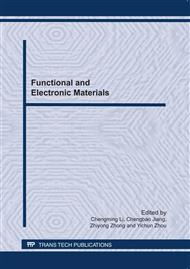p.552
p.557
p.562
p.567
p.571
p.576
p.580
p.585
p.591
Fracture Behavior of Organic Silicon Rubber at Different Extension Rate
Abstract:
Fracture behavior of organic silicon rubber at the extension rate of 100, 300, 500 and 700 mm/min at room temperature was studied in this paper. The fracture surface morphology was observed by scanning electron microscopy (SEM). Effects of different extension rate on the tensile strength tensile fracture behavior and mechanism were investigated. The results showed that fracture of the organic silicon rubber was composed by flat region and rough region, while the rough region was relatively small. With the increasing extension rate, the area of flat region enlarged while rough region decreased, and the secondary cracks appeared when the extension rate reached critical value. The relationship of the tensile strength and elongation with the extension rate were similar, both of which rised and then droped as the extension rate increased, and further studies were needed for the fracture mechanism.
Info:
Periodical:
Pages:
571-575
Citation:
Online since:
June 2011
Authors:
Price:
Сopyright:
© 2011 Trans Tech Publications Ltd. All Rights Reserved
Share:
Citation:


